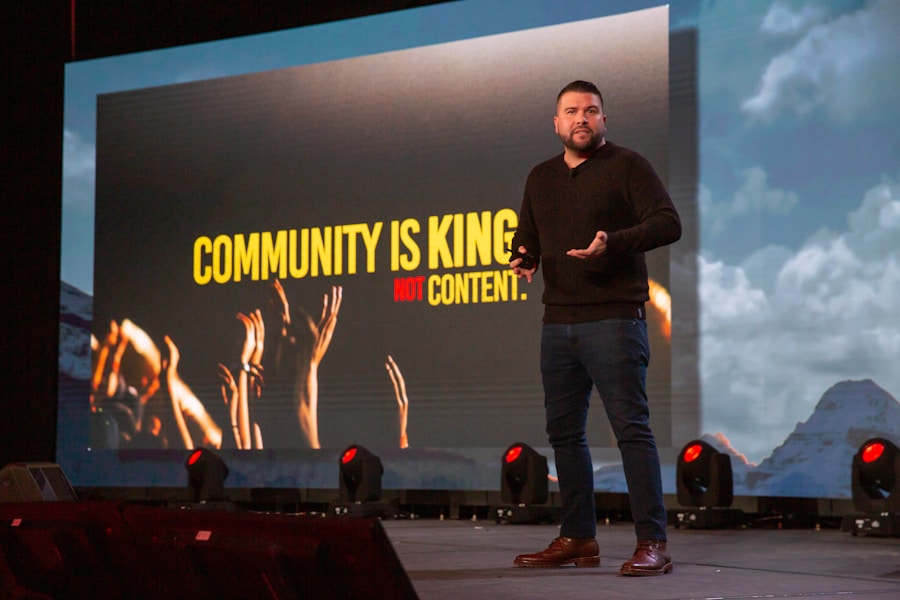In the digital age, the concept of community has transcended physical boundaries, allowing individuals and brands to connect with audiences across the globe. A social media community serves as a virtual gathering place where like-minded individuals can share ideas, experiences, and interests. This sense of belonging is crucial for fostering loyalty and trust among followers.
When a brand cultivates a vibrant community, it not only enhances its visibility but also creates a platform for authentic interactions. These interactions can lead to increased customer retention, as individuals feel more connected to a brand that values their input and fosters dialogue. Moreover, a strong social media community can act as a powerful marketing tool.
When members engage with content and share it within their networks, they effectively become brand advocates. This organic word-of-mouth promotion can significantly amplify a brand’s reach and credibility. For instance, brands like Glossier have successfully built communities around their products by encouraging user-generated content and fostering discussions among beauty enthusiasts.
This not only drives sales but also creates a loyal customer base that feels personally invested in the brand’s success.
Key Takeaways
- Building a social media community is crucial for brand awareness and customer loyalty
- Identifying your target audience helps tailor content and engagement strategies
- Choosing the right social media platforms ensures reaching the right audience
- Creating engaging and valuable content is key to attracting and retaining followers
- Encouraging interaction and engagement fosters a sense of community and loyalty
Identifying Your Target Audience
Understanding who your target audience is essential for building an effective social media community. This process begins with thorough market research, which involves analyzing demographics, interests, and behaviors of potential followers. By creating detailed buyer personas, brands can tailor their messaging and content to resonate with specific segments of their audience.
For example, a fitness brand may identify its target audience as health-conscious millennials who are interested in sustainable living and wellness trends. This insight allows the brand to craft content that speaks directly to these individuals’ values and aspirations. Additionally, identifying your target audience involves leveraging analytics tools available on various social media platforms.
These tools provide valuable insights into who is engaging with your content, including age, gender, location, and interests. By analyzing this data, brands can refine their strategies to better align with their audience’s preferences. For instance, if a brand discovers that a significant portion of its followers are young professionals interested in quick meal solutions, it can pivot its content strategy to include easy-to-make recipes or meal prep tips that cater to this demographic.
Choosing the Right Social Media Platforms
Selecting the appropriate social media platforms is a critical step in building a successful community. Each platform has its unique characteristics and user demographics, which can significantly impact how effectively a brand can engage with its audience. For instance, Instagram is known for its visual-centric content, making it ideal for brands in the fashion, beauty, and food industries.
In contrast, LinkedIn serves as a professional networking site, making it more suitable for B2B companies looking to connect with industry professionals. Furthermore, understanding where your target audience spends their time online is crucial in this decision-making process. Conducting surveys or utilizing analytics tools can provide insights into which platforms your audience prefers.
For example, if your research indicates that your target demographic primarily uses TikTok for entertainment and information, it would be prudent to invest resources into creating engaging short-form video content tailored for that platform. By strategically choosing the right platforms, brands can maximize their reach and engagement potential.
Creating Engaging and Valuable Content
Content is the lifeblood of any social media community; it is what draws users in and keeps them engaged. To create engaging content, brands must focus on delivering value to their audience. This could take the form of informative articles, entertaining videos, or visually appealing graphics that resonate with followers’ interests.
For instance, a travel brand might share stunning photography from various destinations while providing travel tips and itineraries that inspire wanderlust among its audience. Moreover, storytelling plays a pivotal role in crafting compelling content. By sharing authentic stories—whether they are customer testimonials or behind-the-scenes glimpses of the brand—companies can create emotional connections with their audience.
For example, Nike often shares stories of athletes overcoming challenges, which not only showcases their products but also inspires and motivates their community. This approach fosters a deeper connection between the brand and its followers, encouraging them to engage more actively with the content.
Encouraging Interaction and Engagement
Encouraging interaction within your social media community is essential for fostering a sense of belonging among followers. One effective way to achieve this is by posing questions or creating polls that invite users to share their opinions and experiences. For instance, a food brand might ask followers about their favorite recipes or cooking hacks, prompting discussions that allow users to connect over shared interests.
This not only increases engagement but also provides valuable insights into your audience’s preferences. Additionally, hosting live events such as Q&A sessions or webinars can significantly enhance interaction within the community. These events provide an opportunity for real-time engagement, allowing followers to ask questions and receive immediate responses from brand representatives or industry experts.
For example, beauty brands often host live makeup tutorials where followers can ask questions about products or techniques as they watch. This interactive format not only boosts engagement but also positions the brand as an authority in its field.
Building Relationships with Your Followers
Engage Actively with Users
This involves actively engaging with users by responding to comments, messages, and mentions in a timely manner. Acknowledging followers’ contributions fosters a sense of appreciation and encourages them to continue participating in discussions.
Personalize Interactions
Personalizing interactions can further strengthen these relationships. Brands can use followers’ names when responding or reference previous interactions to create a more personalized experience. For example, if a follower shares a photo of themselves using a product on Instagram, the brand could comment on the post by mentioning how great they look or asking about their experience with the product.
Enhance Follower Engagement
Such personalized engagement not only enhances the follower’s experience but also encourages them to remain active participants in the community.
Implementing a Consistent Posting Schedule
Consistency is key when it comes to maintaining an active social media community. Establishing a regular posting schedule helps keep your audience engaged and informed about new content or updates from your brand. By determining optimal posting times based on when your audience is most active—often found through analytics tools—brands can maximize visibility and engagement for each post.
For instance, if analytics reveal that followers are most active during weekday evenings, scheduling posts during those times can lead to higher interaction rates. Additionally, consistency extends beyond just timing; it also encompasses the type of content shared. Brands should strive to maintain a cohesive voice and aesthetic across all posts to reinforce their identity within the community.
For example, if a lifestyle brand focuses on sustainability, all content should reflect this theme—whether it’s showcasing eco-friendly products or sharing tips on reducing waste. By adhering to a consistent posting schedule and maintaining thematic coherence, brands can cultivate an engaged community that looks forward to their content.
Measuring and Analyzing Your Community’s Growth and Engagement
To ensure the effectiveness of your social media community-building efforts, it is essential to measure and analyze growth and engagement metrics regularly. Key performance indicators (KPIs) such as follower growth rate, engagement rate (likes, comments, shares), and reach provide valuable insights into how well your content resonates with your audience. For instance, if you notice a spike in engagement following a specific type of post—such as user-generated content or interactive polls—you can adjust your strategy accordingly to capitalize on what works best.
Furthermore, utilizing social media analytics tools allows brands to track trends over time and identify areas for improvement. By analyzing data such as post performance and audience demographics, brands can refine their content strategies to better align with their community’s preferences. For example, if analytics reveal that video content consistently outperforms static images in terms of engagement, brands may choose to prioritize video production in their content calendar moving forward.
This data-driven approach ensures that brands remain responsive to their community’s needs while continuously enhancing engagement levels. In conclusion, building a successful social media community requires a multifaceted approach that encompasses understanding your audience, creating valuable content, fostering engagement, and analyzing performance metrics. By prioritizing these elements, brands can cultivate vibrant communities that not only enhance their online presence but also drive meaningful connections with followers.
FAQs
What is social media community building?
Social media community building is the process of creating and nurturing a group of engaged and loyal followers on social media platforms. It involves fostering a sense of belonging, encouraging interaction, and providing value to the community members.
Why is building a community on social media important?
Building a community on social media is important because it allows businesses and individuals to connect with their audience on a deeper level, build brand loyalty, and increase customer retention. It also provides a platform for sharing valuable content and gathering feedback.
What are some strategies for building a community on social media?
Some strategies for building a community on social media include consistently posting valuable and relevant content, engaging with followers through comments and messages, hosting live events or Q&A sessions, and creating a sense of belonging by encouraging user-generated content and discussions.
How can businesses benefit from building a community on social media?
Businesses can benefit from building a community on social media by increasing brand awareness, fostering customer loyalty, gaining valuable insights and feedback, and ultimately driving sales and conversions. A strong social media community can also serve as a valuable marketing and customer service tool.
What are some common challenges in building a community on social media?
Some common challenges in building a community on social media include attracting and retaining engaged followers, managing negative feedback or trolls, staying consistent with content creation, and keeping up with the ever-changing algorithms and trends of social media platforms.


